
table of contents
- Trees with heart-shaped leaves from A to F.
- G to R
- S to Z
- frequently asked Questions
Heart-shaped leaves grace trees tastefully. Some specimens can be found in Central Europe and easily identified by the properties of their leaves. The following 14 large heart-leaved tree species / varieties with the most important distinguishing features.
In a nutshell
- heart-shaped leaves sometimes clearly recognizable, sometimes indicated
- heart-leaved trees all with flowers
- mostly summer flowering
- large leaves only on tall trees
Trees with heart-shaped leaves from A to F.
American lime tree (Tilia americana)

- Growth: spreading, upright, loose
- Height: 20 to 30 meters
- Flower: yellow; July; Umbels; strongly fragrant
- Leaves: heart-shaped; up to 20 inches long and wide; sawn leaf edge; Stem five centimeters; yellow autumn colors
- Special features: stands on sandy-clay soil; forms nutty, inedible fruits
American linden "Nova" / Giant-leaved American linden ("Tilia americana 'Nova'")
- Growth: spreading, upright, loose
- Height: up to 25 meters
- Flowers: yellow in June; yellow-green umbels attached in July; strongly fragrant
- Leaves: oval; heart-shaped leaves; up to 20 inches long and wide; sawn leaf edge; Stem up to seven centimeters; yellow-brown autumn colors
- Special features: stands on sandy-clay soil; forms nutty, inedible fruits; greenish bark - changes to gray-black with age; only American linden varieties with longer heart leaves; often seen as a park tree
Tree hazel / Turkish hazel (Corylus colurna)
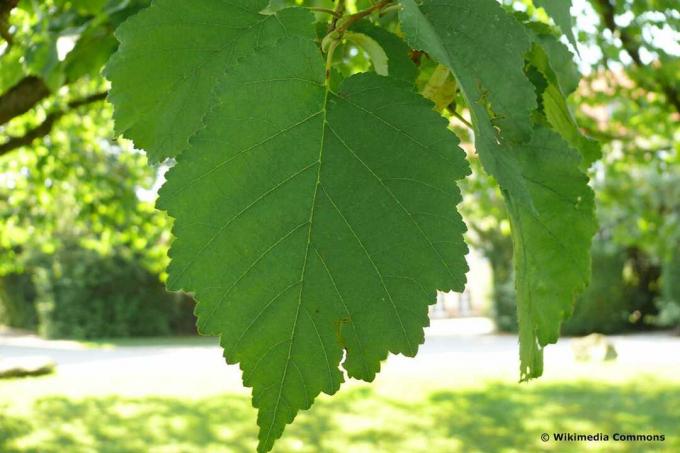
- Growth: conical wide growth; slowly growing
- Height: between 12 and 20 meters
- Flower: simple; green yellow; up to ten centimeters tall: from February to March
- broad, egg to heart-shaped leaves with autumn colors; double sawn; up to twelve centimeters in length
- Special features: ideal street tree; edible hard nuts; tolerates intense heat; pretty tough
Tip: The appearance of the leaves is the best way to identify trees. Every tree has at least one different characteristic, but this is where you should look very carefully. The other distinguishing features such as flower and growth habit make identification even easier.
Chinese bluebell tree / imperial tree (Paulownia tomentosa)
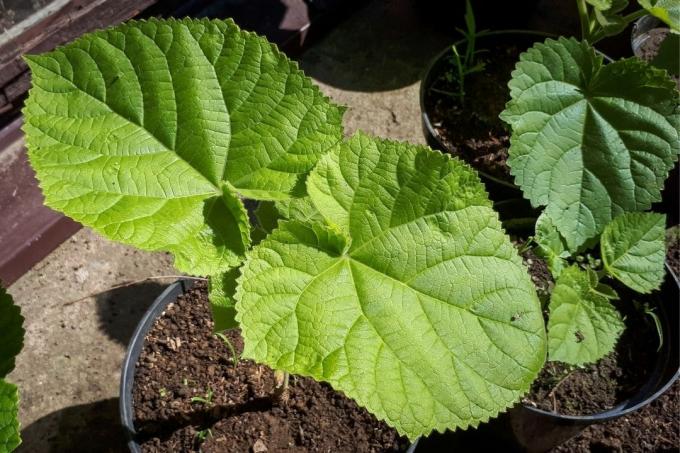
- Growth: stiff shoot growth; loose and broad; fast growing
- Height: between eight and 15 meters
- Flower: panicle-shaped; blue-purple; from April to May
- very large heart-shaped leaves with a brownish autumn color; up to 30 centimeters: arranged opposite; hairy
- Special features: hardy down to minus 17.8 degrees; forms inedible nuts; widespread variety "Paulownia imperialis"
G to R
Yellow Trumpet Tree / Small-flowered Trumpet Tree (Catalpa ovata)
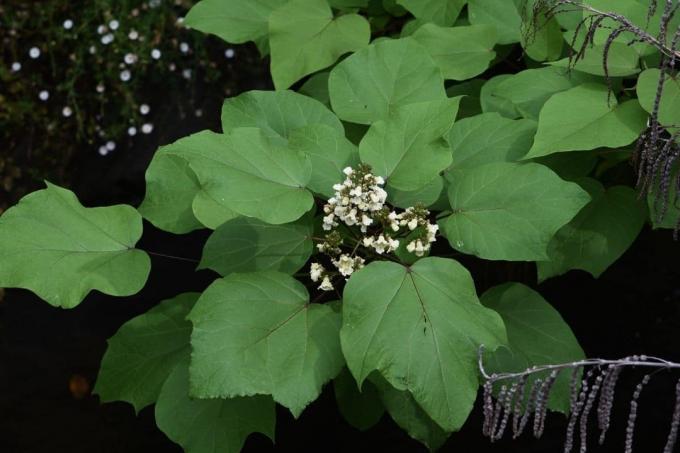
- Growth: spreading; upright
- Height: between twelve and 30 meters (just as wide)
- Flower: white; Umbels; June to July; intensely fragrant
- Leaves: heart-shaped, pointed leaves; Autumn colors
- Special features: fruit pods up to 30 centimeters long; gray-brown bark; Longitudinal cracks in the bark of older trees
Note: The trumpet tree contains catalpin. This is a toxin that is found in all parts of the plant, with the exception of the seeds. Although the content is low, it can lead to allergic skin reactions if it comes into contact with the body.
Common trumpet tree (Catalpa bignonioides)
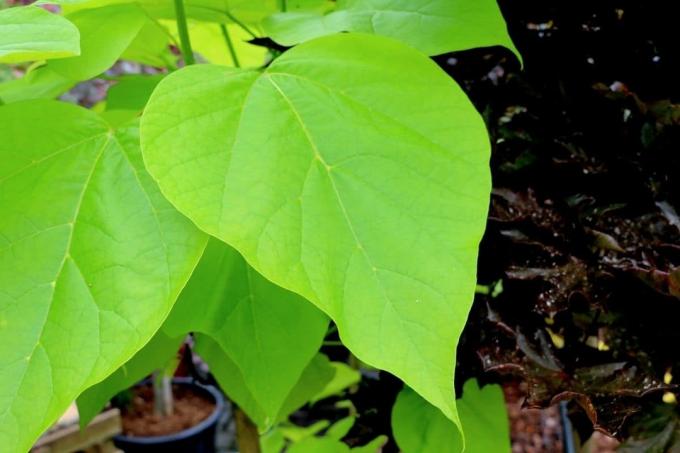
- Growth: round, spherical; wide
- Height: between ten and 15 meters
- Flower: white; panicle-shaped; from June to July; intensely fragrant
- Leaves: heart-shaped; short hairy; up to 20 centimeters tall; light green leaf veins; smooth leaf margin; long stems; alternate; bright yellow autumn colors
- Special features: late budding; bean-like fruits up to 35 centimeters in size; flowers profusely; hardy only in old age
Henry's Lime / Asiatic Lime (Tilia henryana)
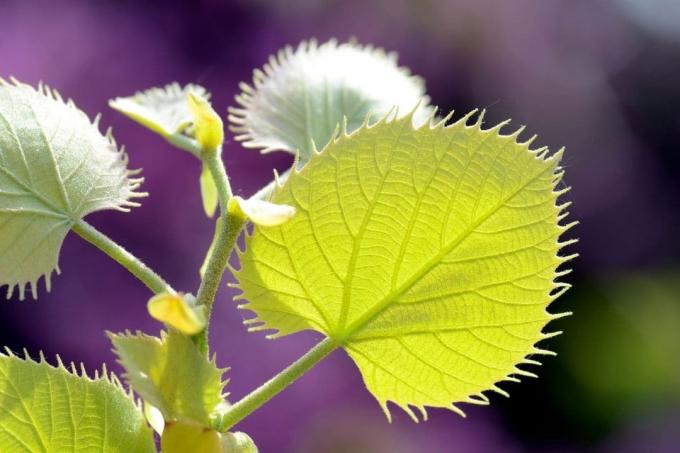
- Growth: heavily branched; Crown oval; towering; slowly growing
- Height: between eight and twelve meters
- Flower: umbel-shaped; creamy yellow; White; up to five centimeters in size; from the beginning of August to the middle / end of September
- egg to heart-shaped leaves; light green; noticeable teeth; hairy; alternate red or yellow stalk perpendicular to the leaf
- Special features: spherical nuts; very bee-friendly; flowers profusely; hardy to 19 degrees Celsius
Dutch lime tree (Tilia x europaea)

- Growth: spreading; upright
- Height: between 25 and 40 meters
- Flower: yellowish-white; umbel-shaped; from June to July; strongly fragrant
- Blade: serrated; pointed, heart-shaped; light to medium green; up to twelve centimeters in size
- Special features: nectar or pollen plant; bee-friendly wood; brown inedible nuts; prefers loamy-gravelly soil
Crimean linden (Tilia x euchlora)

- Growth: cone-like; upright
- Height: between 15 and 20 meters
- Flower: umbel-shaped; yellow; from July to August
- heart-shaped; up to ten centimeters tall; sharply sawn edge; Upper side dark green, shiny; Underside matt green; yellow autumn colors
- Special features: hybrid; bee-friendly nectar tree; prefers to grow on sandy-loamy soil
S to Z
Black Alder (Alnus glutinosa)

- Growth: straight trunk to crown; light, pyramidal crown growth
- Height: between 25 and 30 meters
- Flower: umbel-shaped; Brown; from March to April;
- Leaves: four to nine centimeters wide leaf blade; usually bordered at the front or slightly pointed to the shape of a heart; dark green top; yellow hairs on the underside; brown autumn colors
- Special features: brownish-green bark changes to gray-brown with age; old trees often elongated or square cracks in the bark; summer green; "Kitten education"; Side shoots without buds; very frost hardy
Silver linden (Tilia tomentosa)

- Growth: upright; fast growing
- Height: between 20 and 30 meters
- Flower: hermaphrodite; cymes seven to ten centimeters long; yellow; from June to August (July “high season); strongly fragrant
- Leaves: clearly heart-shaped leaves; up to ten centimeters in size; sharply serrated leaf margins; dark green leaf upper side; white, slightly felted underside; alternate
- Special features: summer green; often used as a privacy screen; greenish, spherical nuts; felty young shoots; brown hairy buds; shallow furrows in gray-green bark; prefers sunny locations
Summer linden (Tilia platyphyllos)

- Growth: upright; expansive
- Height: between 30 and 40 meters
- Flower: yellow; Umbels; from June to July; strongly fragrant
- crooked heart leaf: ten to 15 centimeters in size; slightly wavy; sawn; stem three to seven centimeters long; dark green top; Underside lighter; hairy all around; yellow autumn colors
- Special features: one of the most beautiful local deciduous trees; very bee-friendly; brown nuts; Self-sowing
Handkerchief tree / pigeon tree (Davidia involucrata var. vilmoriniana)

- Habit: shrubby-tree-like; relaxed; heavily branched; oval crown
- Height: between six and eight meters; in optimal conditions occasionally up to 20 meters
- Flower: white bracts that hang down like handkerchiefs; from May to June
- Leaves: fresh green; Leaf underside glossy light green to greyish; broad egg shape with heart-shaped base; roughly toothed to sawn; eight to 14 centimeters in length; between seven and twelve centimeters wide; alternate growth; red-brown autumn colors; reddish petioles five inches long
- Special features: hardy to minus 20 degrees Celsius; Asian origin; rare tree; very floriferous; flaky, gray-brown bark; high decorative value
Winter linden / stone linden (Tilia cordata)
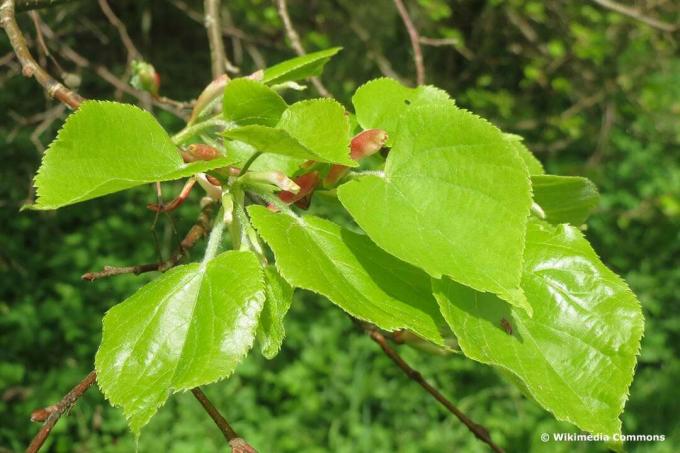
- Growth: upright; expansive; broad conical crown
- Height: between twelve and 30 meters (can be just as wide)
- Flower: white cymes; Late June to July; intensely fragrant
- Leaves: heart-shaped, pointed leaves; six to eight inches tall; dark green; yellow-greenish autumn colors
- Special features: well-known courtyard, street and park trees; can live for a few hundred years; sweet smelling flowers
Note: The winter linden tree is easy to confuse with the summer linden tree. They can be distinguished from one another by means of the leaves, because those of the winter linden tree are completely hairless and those of the summer linden tree completely hairy.
frequently asked Questions
Trees with large leaves cast significantly larger shadows than smaller-leaved specimens. The shape of the leaf does not matter. Therefore, always make sure that sun-hungry plant neighbors and, if necessary, lawns are far enough away from the shaded areas. In addition, the large leaf areas can lead to increased water evaporation. Trees that cannot cope well with drought should therefore be watered noticeably more frequently during the summer months.
Heart-shaped leaves are not uncommon and can also be found in other types of plants, including shrubs. These include, for example, the spiked false hazel (Corylopsis spicata), arm-flowered false hazel (Corylopsis pauciflora), Bittersweet nightshade (Solanum dulcamara) and the Japanese pearl tail (Stachyurus praecox) with egg-oval to heart-shaped Scroll.
The most famous is the Chinese Judas tree (Cercis chinensis). Its foliage attains a size between seven and twelve centimeters. Overall, however, they are more compact, which is why this tree is not named in the above list.
As a rule, the heart shape determines the entire foliage pattern. Developmental disorders can only occur through different lighting conditions and nutrient supplies. If, for example, too little light reaches some leaves, the shape is often less pronounced. This sometimes creates straight lines where there should actually be a curve. However, these are exceptional cases, which does not change the leaf shape typical of the tree.
